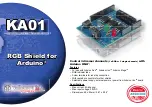
Rev. 1.00
16
March 24, 2020
Rev. 1.00
17
March 24, 2020
BS83A04C
4-Key Enhanced Touch I/O Flash MCU
BS83A04C
4-Key Enhanced Touch I/O Flash MCU
The lower byte of the Program Counter, known as the Program Counter Low register or PCL, is
available for program control and is a readable and writeable register. By transferring data directly
into this register, a short program jump can be executed directly; however, as only this low byte
is available for manipulation, the jumps are limited to the present page of memory that is 256
locations. When such program jumps are executed it should also be noted that a dummy cycle
will be inserted. Manipulating the PCL register may cause program branching, so an extra cycle is
needed to pre-fetch.
Stack
This is a special part of the memory which is used to save the contents of the Program Counter
only. The stack is organized into 4 levels and neither part of the data nor part of the program space,
and is neither readable nor writeable. The activated level is indexed by the Stack Pointer, and is
neither readable nor writeable. At a subroutine call or interrupt acknowledge signal, the contents of
the Program Counter are pushed onto the stack. At the end of a subroutine or an interrupt routine,
signaled by a return instruction, RET or RETI, the Program Counter is restored to its previous value
from the stack. After a device reset, the Stack Pointer will point to the top of the stack.
If the stack is full and an enabled interrupt takes place, the interrupt request flag will be recorded but
the acknowledge signal will be inhibited. When the Stack Pointer is decremented, by RET or RETI,
the interrupt will be serviced. This feature prevents stack overflow allowing the programmer to use
the structure more easily. However, when the stack is full, a CALL subroutine instruction can still
be executed which will result in a stack overflow. Precautions should be taken to avoid such cases
which might cause unpredictable program branching.
If the stack is overflow, the first Program Counter save in the stack will be lost.
Stack Level 2
Stack Level 1
Stack Level 3
Program Memory
Program Counter
Top of Stack
Stack Level 4
Bottom of Stack
Stack
Pointer
Arithmetic and Logic Unit – ALU
The arithmetic-logic unit or ALU is a critical area of the microcontroller that carries out arithmetic
and logic operations of the instruction set. Connected to the main microcontroller data bus, the ALU
receives related instruction codes and performs the required arithmetic or logical operations after
which the result will be placed in the specified register. As these ALU calculation or operations may
result in carry, borrow or other status changes, the status register will be correspondingly updated to
reflect these changes. The ALU supports the following functions:
• Arithmetic operations:
ADD, ADDM, ADC, ADCM, SUB, SUBM, SBC, SBCM, DAA
• Logic operations:
AND, OR, XOR, ANDM, ORM, XORM, CPL, CPLA
• Rotation:
RRA, RR, RRCA, RRC, RLA, RL, RLCA, RLC
• Increment and Decrement:
INCA, INC, DECA, DEC
• Branch decision:
JMP, SZ, SZA, SNZ, SIZ, SDZ, SIZA, SDZA, CALL, RET, RETI















































